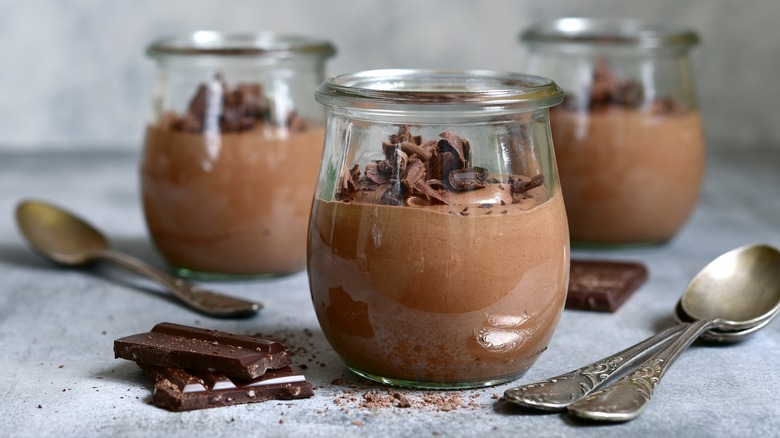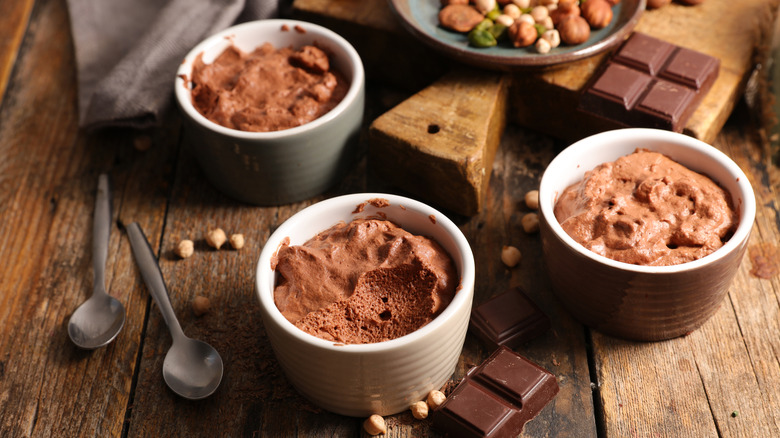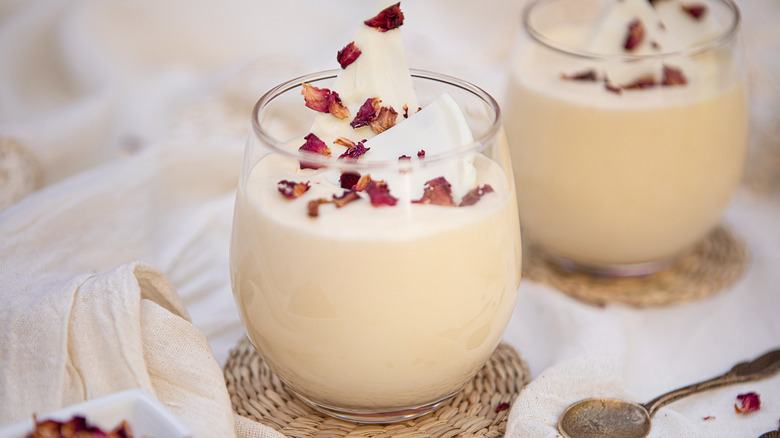Why Chocolate Mousse Was Once Called Mayonnaise
Chocolate mousse belongs in the hall of fame of classic desserts — it's so creamy and airy that it's almost ethereal, yet it manages to deliver a deep and rich chocolate flavor. It's no wonder why dessert lovers have been enjoying this treat for centuries, and while its formula hasn't been altered much, chocolate mousse has undergone a big name change. In its native French, this dessert was once known as "mayonnaise au chocolat" or "mayonnaise de chocolat," or in English, "chocolate mayonnaise."
Imagining chocolate-flavored mayonnaise might turn your stomach, but the name is less literal than it seems. There are no historical records that explain exactly why chocolate mousse went by this name, but the dessert is more similar to mayo than you might realize. To make a classic version of chocolate mousse, egg yolks are gently cooked over a double boiler and then combined with chocolate. Whipped egg whites and whipped cream and then folded in to create a creamy, airy texture. Meanwhile, homemade mayonnaise starts with whole eggs or egg yolks that are mixed vigorously with oil and vinegar until smooth.
In short, both mousse and mayo are egg-based mixtures with rich, creamy consistencies, which may explain the playful moniker of "mayonnaise au chocolate." However, food history is nothing if not complicated, and while chocolate mousse's early name might be fairly easy to understand, its possible origin story is often contested and argued with.
Was chocolate mousse really invented by a famed painter?
It's widely believed that French painter Henri Toulouse-Lautrec created chocolate mousse in the late 19th century. Toulouse-Lautrec was an experimentalist cook in addition to an artist, and this story says that he came up with both the recipe and the name of "mayonnaise de chocolat." However, there are printed recipes for "mousse au chocolat” or "chocolate mousse" from earlier times, in the years 1768, 1814, and 1827.
It's important to note that the French word "mousse" means "to froth" — it's not a term exclusive to the dessert. Even earlier references to the term "chocolate mousse" also exist, but they are attached to beverages, rather than a spoonable sweet treat. In one use of the term, a 1687 printing of "Le Bon usage du thé, du caffé et du chocolat pour la préservation & pour la guérison des maladies" (say that five times fast) describes Central American indigenous people frothing their own unique chocolate beverages. A similar practice is mentioned in a French dictionary from 1701, in a definition for the verb "mousser."
With these historical documents in mind, as well as other mentions from the 18th and early 19th centuries, it's likely that chocolate mousse predates the post-Impressionist period that Monsieur Toulouse-Lautrec thrived in. What we do know for sure is that the mousse later gained a boost of popularity that has cemented its place in the classic dessert canon.
America later fell in love with chocolate mousse
Chocolate mousse eventually crossed the ocean from France to the United States, and was introduced to Americans at a 1892 food exposition in New York City. But the pinnacle of its popularity arose in the mid-20th century, thanks to recipes from Julia Child's beloved book "Mastering the Art of French Cooking" as well as a Betty Crocker cookbook. Chocolate mousse is still considered a retro dessert by some, but has also evolved into new and exciting forms.
Today, you can find recipes for eggless chocolate mousse for those with allergies, dietary restrictions, or who simply prefer not to eat uncooked eggs. Low-sugar and dairy-free variations are also easy to find, and in 1977, New York-based chef Michel Fitoussi popularized white chocolate mousse to rave reviews. Beyond modifying the basic formula, the dessert's flavor can be switched up in countless ways. You might add a complementary intensity to dark chocolate mousse by using orange peel and whiskey, or try cayenne pepper and cinnamon for a version inspired by Mexican hot chocolate.
If you prefer a white chocolate mousse a la Fitoussi, try whipping up your own version and topping with fresh berries, whipped cream, and maybe a sprinkling of Meyer lemon zest. You could even create a stunning, unique mousse with fruity ruby chocolate. From "chocolate mayonnaise" to its many modern iterations, it's easy to see how anyone from any time period could fall in love with this treat.



